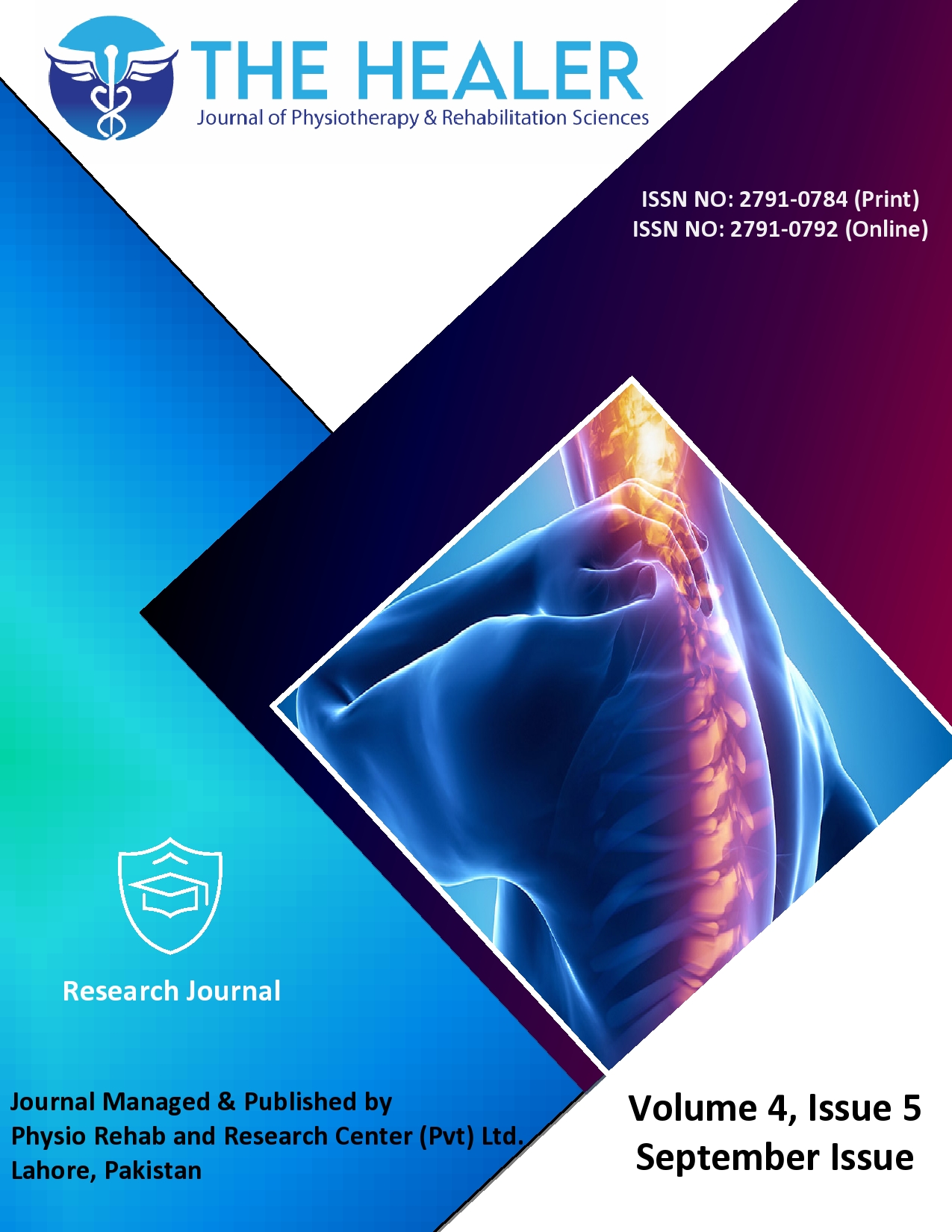Postoperative Complications of Anaesthesia following Appendectomy
Complications of Anaesthesia following Appendectomy
DOI:
https://doi.org/10.55735/hjprs.v4i5.287Keywords:
Acute Appendictics, Anaesthesia, Open Appendectomy, Post-operative ComplicationsAbstract
Background: Appendectomy is usually performed as an urgent or emergency operation to treat severe acute appendicitis. Surgical technique has moved usually toward laparoscopic appendectomy in the early 21st century. Common post-operative complications following appendectomy patients included fever, hypotension, hypertension, hypothermia, and death. Objective: To identify the postoperative complications of anaesthesia following appendectomy. Methodology: This cross-sectional study was conducted using a convenient sampling technique. Data was collected through a questionnaire comprising questions related to post-operative complications following appendectomy. The sample size was 79 calculated based on prevalence (28.60%). Patients who underwent appendectomy were included in the study. Pediatric patients and laparoscopic surgeries were excluded. A total of 79 participants were investigated during this research. The participants were informed that there was no risk involved during this study. The postoperative complications of appendectomy like nausea, vomiting, pain, hypertension, hypotension and blood loss were noted. For the variables like age and gender mean and standard deviation were calculated and the frequency was used for the rest of the variables. Results: About 43 patients (54.4%) experienced periumbilical pain and 36(45.6%) patients did not experience periumbilical pain. 23(29.1%) patients had vomiting 56 (70.9%) patients did not experience vomiting. 16(20.3%) experienced agitation and 63 (79.7%) patients did not experience agitation.17 (21.5%) patients had bleeding and 62 (78.5%) patients did not have bleeding. 23 (29.1%) patients had hypoxia and 56(70.9%) patients didn’t experienced Hypoxia. 10(12.7%) patients had hypothermia and 69 (87.3%) patients did not have hypothermia. 13(16.5%) patients had hypertension and 66 (83.5%) patients did not have hypertension.8(10.1%) patients had hypotension and 71(89.9%) patients did not experienced hypotension. While 26(32.9%) had fever and 53(67.1%) did not have fever. Conclusion: It is concluded that there were minimum complications after surgery and patients did not complain about any severe illness after appendectomy.
Downloads
References
Kelz MB, Mashour GAJCB. The biology of general anesthesia from Paramecium to primate. 2019; 29(22): R1199-R210.
Gray K, Adhikary SD, Janicki PJJoa, clinical pharmacology. Pharmacogenomics of analgesics in anesthesia practice: A Current Update of Literature. 2018; 34(2): 155.
Dowell D, Haegerich TM, Chou RJJ. CDC guideline for prescribing opioids for chronic pain—United States, 2016. 2016; 315(15): 1624-45.
Torpy JM, Burke AE, Golub RM. JAMA patient page. Appendectomy. JAMA. 2011; 306(21): 2404.
Salam SS, Chinglensana L, Priyabarta Y, Sharma MBJJoEoM, Sciences D. Acute appendicitis in elderly patients-challenges in diagnosis and management. 2018; 7(32): 3585-90.
Kandaan AURJJoSP. Antibiotic Therapy Versus Appendectomy for Uncomplicated Acute Appendicitis. 2020; 25(1): 3-7.
Macfarlane A, Prasad G, Chan V, Brull RJBjoa. Does regional anaesthesia improve outcome after total hip arthroplasty? A Systematic Review. 2009; 103(3): 335-45.
Latif A, Bhatti MF, Qadir A, Shahwar ZA, Shahzad SJPJOM, SCIENCES H. Effectiveness of Anaesthesia for Appendicectomy: comparison of spinal anaesthesia with other modalities being practiced in Emergency Department of Allama Iqbal Memorial Teaching Hospital. 2017; 11(4): 1402-6.
Biondi A, Di Stefano C, Ferrara F, Bellia A, Vacante M, Piazza LJWJoES. Laparoscopic versus open appendectomy: a retrospective cohort study assessing outcomes and cost-effectiveness. 2016; 11(1): 1-6.
Akporiaye ET, Aminoff MJ, Basbaum AI, Benowitz NL, Berkowitz BA, Bikle DD, et al. Bertram G. Katzung, MD, PhD.
Clark MA, Finkel R, Rey JA, Whalen K. Lippincott's illustrated reviews: pharmacology: Wolters Kluwer Health/Lippincott Williams & Wilkins; 2012.
Kain ZN, Fitch JC, Kirsch JR, Mets B, Pearl RGJA. Future of anesthesiology is perioperative medicine: a call for action. 2015; 122(6): 1192-5.
Brown EN, Pavone KJ, Naranjo MJA, analgesia. Multimodal general anesthesia: theory and practice. 2018; 127(5): 1246.
Verlinde M, Hollmann MW, Stevens MF, Hermanns H, Werdehausen R, Lirk PJIjoms. Local anesthetic-induced neurotoxicity. 2016; 17(3): 339.
Tao K-m, Sokha S, Yuan H-bJBhsr. The challenge of safe anesthesia in developing countries: defining the problems in a medical center in Cambodia. 2020; 20(1): 1-10.
Braz LG, Braz DG, Cruz DSd, Fernandes LA, Módolo NSP, Braz JRCJC. Mortality in anesthesia: a systematic review. 2009; 64(10): 999-1006.
Tennant I, Augier R, Crawford-Sykes A, Ferron-Boothe D, Meeks-Aitken N, Jones K, et al. Minor postoperative complications related to anesthesia in elective gynecological and orthopedic surgical patients at a teaching hospital in Kingston, Jamaica. 2012; 62(2): 188-98.
Robinson DH, Toledo AHJJoIS. Historical development of modern anesthesia. 2012; 25(3): 141-9.
Barash PG. Clinical anesthesia: Lippincott Williams & Wilkins; 2009.
Ferguson C, Araújo D, Faulk L, Gou Y, Hamelers A, Huang Z, et al. Europe PMC in 2020. 2021; 49(D1): D1507-D14.
Gottschalk A, Van Aken H, Zenz M, Standl TJDÄI. Is anesthesia dangerous? 2011; 108(27): 469.
Lienhart A, Auroy Y, Pequignot F, Benhamou D, Warszawski J, Bovet M, et al. Survey of anesthesia-related mortality in France. 2006; 105(6): 1087-97.
Maldonado NJEmp. Evidence-based management of suspected appendicitis in the emergency department. 2011; 2.
Suh YJ, Jeong S-Y, Park KJ, Park J-G, Kang S-B, Kim D-W, et al. Comparison of surgical-site infection between open and laparoscopic appendectomy. 2012; 82(1): 35.
Khalil J, Muqim R, Rafique M, Khan MJSjogojotSGA. Laparoscopic versus open appendectomy: a comparison of primary outcome measures. 2011; 17(4): 236.
Rasmussen T, Fonnes S, Rosenberg JJSJoS. Long-term complications of appendectomy: a systematic review. 2018; 107(3): 189-96.
Chen C-C, Ting C-T, Tsai M-J, Hsu W-C, Chen P-C, Lee M-D, et al. Appendectomy timing: Will delayed surgery increase the complications? 2015; 78(7): 395-9.
Paquette IM, Zuckerman R, Finlayson SRJAos. Perforated appendicitis among rural and urban patients: implications of access to care. 2011; 253(3): 534-8.
Humes D, Simpson JJB. Acute appendicitis. 2006; 333(7567): 530-4.
Ball C, Kortbeek J, Kirkpatrick A, Mitchell PJSe. Laparoscopic appendectomy for complicated appendicitis: an evaluation of postoperative factors. 2004; 18(6): 969-73.
Shimoda M, Maruyama T, Nishida K, Suzuki K, Tago T, Shimazaki J, et al. Comparison of clinical outcome of laparoscopic versus open appendectomy, single center experience. 2018; 4(5): e00635.
Clark VL, Kruse JAJJ. Clinical methods: the history, physical, and laboratory examinations. 1990; 264(21): 2808-9.
Shaikh SI, Nagarekha D, Hegade G, Marutheesh MJA, essays, researches. Postoperative nausea and vomiting: A simple yet complex problem. 2016; 10(3): 388.
Smania MC, Piva JP, Garcia PCRJRdAMB. Dexmedetomidine in anesthesia of children submitted to videolaparoscopic appendectomy: a double-blind, randomized and placebo-controlled study. 2008; 54(4): 308-13.
Melesse DY, Denu ZA, Kassahun HG, Agegnehu AFJIJoSO. The incidence of early post-operative hypoxemia and its contributing factors among patients underwent operation under anesthesia at University of Gondar comprehensive and specialized referral hospital, Gondar, North West Ethiopia, 2018. A prospective observational study. 2020; 22: 38-46.
Mendonça FT, de Lucena MC, Quirino RS, Govêia CS, Guimarães GMNJBJoA. Risk factors for postoperative hypothermia in the post-anesthetic care unit: a prospective prognostic pilot study. 2019; 69(2): 122-30.

Downloads
Published
License
Copyright (c) 2024 The Healer Journal of Physiotherapy and Rehabilitation Sciences

This work is licensed under a Creative Commons Attribution 4.0 International License.














